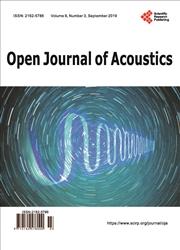有源噪声控制在牙科治疗上的应用仿真 Application Simulation of Active Noise Control in Dental Treatment
引用次数: 1
Abstract
本文介绍了有源噪声控制的应用,并分析了有源噪声控制的基本原理,指出在实际应用中对于无法测得有效的原噪声信号情况中,需要采用反馈控制系统。由于通过自适应反馈控制系统可以避免取得源噪声的相关信号,因而本文对于FXLMS算法进行分析,与传统LMS算法相比,FXLMS算法考虑了牙科设备如电机驱动牙钻或气动涡轮机驱动牙钻中的次级信道并进行了补偿,因而更加适用于牙科领域的自适应有源消声。文中最后对于牙科噪声进行探究,并给出不同参考信号与不同牙科噪声下的仿真结果。 This paper introduces the application of active noise control technology, and analyzes the funda-mental of it. The paper points out that it is necessary to use a feedback control system when the original noise information can’t be reached. Since designing an adaptive feedback system can meet this requirement, the paper focuses on the FXLMS algorithm. Compared with traditional LMS algo-rithm, FXLMS algorithm can compensate the second channel in the dental device such as electro-motor driven dental drill or air turbine driven drill, which LMS algorithm doesn’t take into account. At last, the paper analyzes the dental noise from dental drills and simulates the performance of FXLMS algorithm in different situations, such as different reference signals and different noises.有源噪声控制在牙科治疗上的应用仿真 Application Simulation of Active Noise Control in Dental Treatment
本文介绍了有源噪声控制的应用,并分析了有源噪声控制的基本原理,指出在实际应用中对于无法测得有效的原噪声信号情况中,需要采用反馈控制系统。由于通过自适应反馈控制系统可以避免取得源噪声的相关信号,因而本文对于FXLMS算法进行分析,与传统LMS算法相比,FXLMS算法考虑了牙科设备如电机驱动牙钻或气动涡轮机驱动牙钻中的次级信道并进行了补偿,因而更加适用于牙科领域的自适应有源消声。文中最后对于牙科噪声进行探究,并给出不同参考信号与不同牙科噪声下的仿真结果。 This paper introduces the application of active noise control technology, and analyzes the funda-mental of it. The paper points out that it is necessary to use a feedback control system when the original noise information can’t be reached. Since designing an adaptive feedback system can meet this requirement, the paper focuses on the FXLMS algorithm. Compared with traditional LMS algo-rithm, FXLMS algorithm can compensate the second channel in the dental device such as electro-motor driven dental drill or air turbine driven drill, which LMS algorithm doesn’t take into account. At last, the paper analyzes the dental noise from dental drills and simulates the performance of FXLMS algorithm in different situations, such as different reference signals and different noises.
本文章由计算机程序翻译,如有差异,请以英文原文为准。
求助全文
约1分钟内获得全文
求助全文

 求助内容:
求助内容: 应助结果提醒方式:
应助结果提醒方式:


